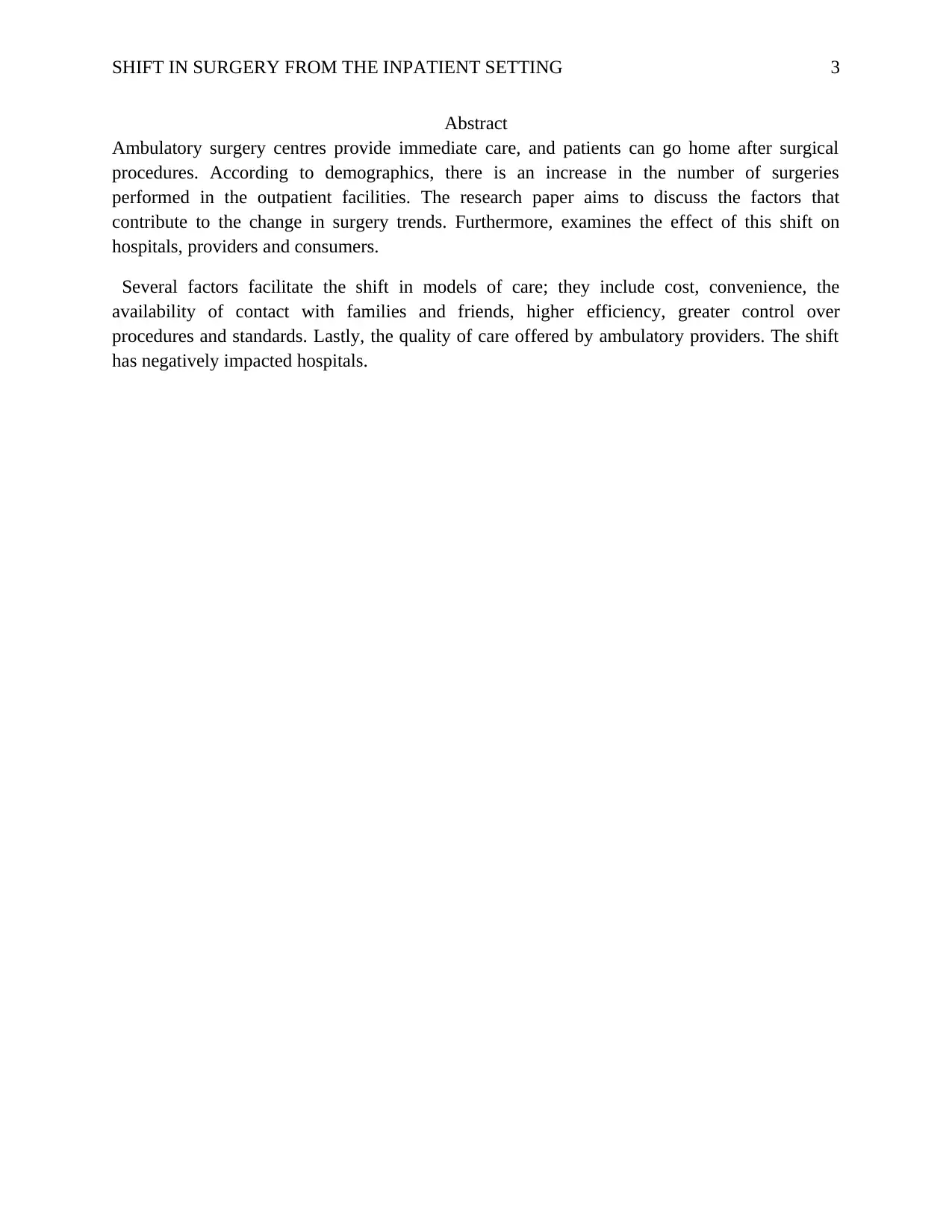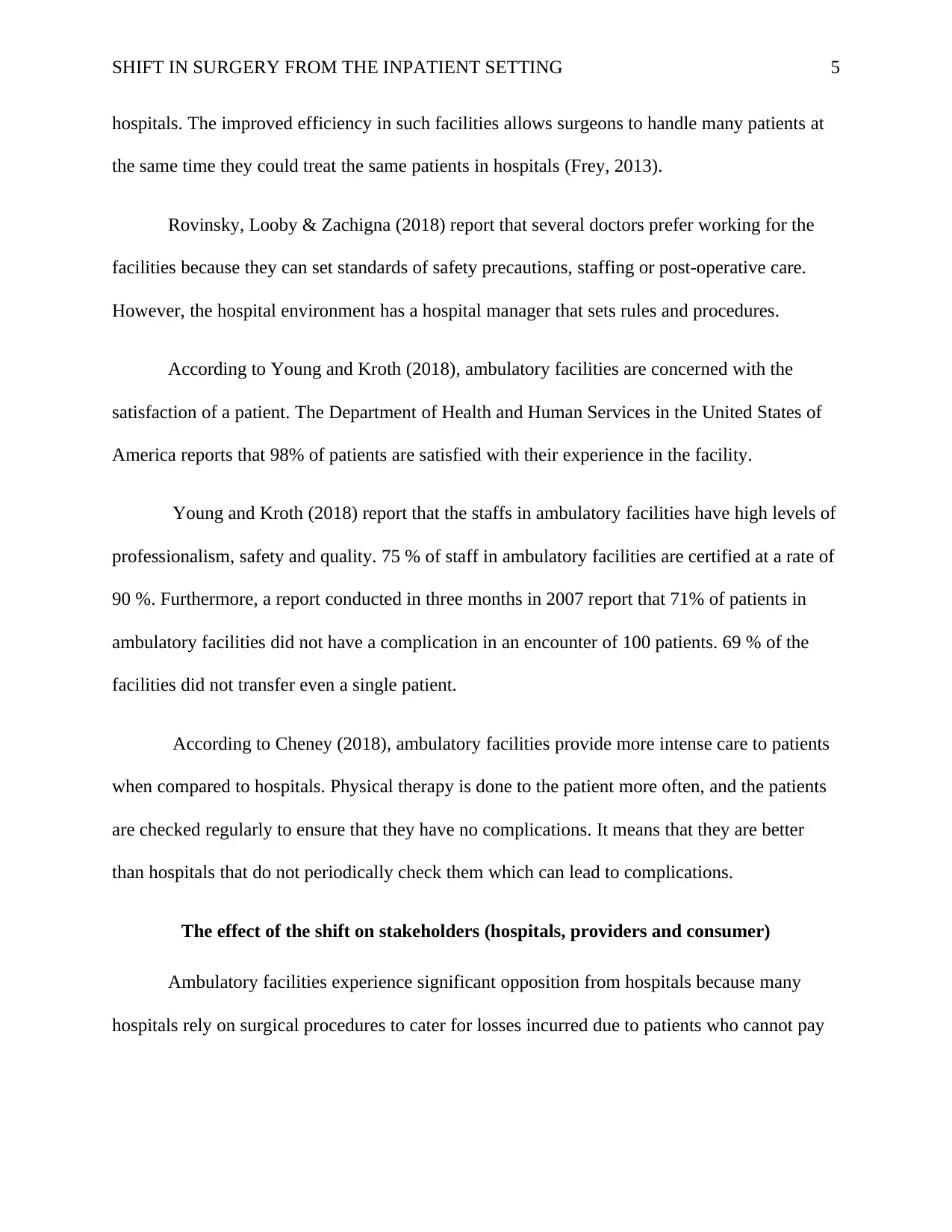Shift in Surgery from the Inpatient Setting
VerifiedAdded on 2023/04/24
|7
|1219
|342
AI Summary
This research paper discusses the factors contributing to the shift in surgery trends from inpatient to outpatient facilities and examines the effect of this shift on hospitals, providers, and consumers. The factors include cost, convenience, availability of contact with families and friends, higher efficiency, greater control over procedures and standards, and the quality of care offered by ambulatory providers. The shift has negatively impacted hospitals.
Contribute Materials
Your contribution can guide someone’s learning journey. Share your
documents today.

Running Head: SHIFT IN SURGERY FROM THE INPATIENT SETTING 1
The shift in Surgery from the Inpatient Setting
Name
Institution
Authors Note
The shift in Surgery from the Inpatient Setting
Name
Institution
Authors Note
Secure Best Marks with AI Grader
Need help grading? Try our AI Grader for instant feedback on your assignments.

SHIFT IN SURGERY FROM THE INPATIENT SETTING 2
Table of contents
Abstract.......................................................................................................................................................3
Introduction.................................................................................................................................................4
Factors contributing to the shift in surgery from the inpatient setting......................................................4
The effect of the shift on stakeholders (hospitals, providers and consumer)............................................5
Conclusion...................................................................................................................................................6
Table of contents
Abstract.......................................................................................................................................................3
Introduction.................................................................................................................................................4
Factors contributing to the shift in surgery from the inpatient setting......................................................4
The effect of the shift on stakeholders (hospitals, providers and consumer)............................................5
Conclusion...................................................................................................................................................6

SHIFT IN SURGERY FROM THE INPATIENT SETTING 3
Abstract
Ambulatory surgery centres provide immediate care, and patients can go home after surgical
procedures. According to demographics, there is an increase in the number of surgeries
performed in the outpatient facilities. The research paper aims to discuss the factors that
contribute to the change in surgery trends. Furthermore, examines the effect of this shift on
hospitals, providers and consumers.
Several factors facilitate the shift in models of care; they include cost, convenience, the
availability of contact with families and friends, higher efficiency, greater control over
procedures and standards. Lastly, the quality of care offered by ambulatory providers. The shift
has negatively impacted hospitals.
Abstract
Ambulatory surgery centres provide immediate care, and patients can go home after surgical
procedures. According to demographics, there is an increase in the number of surgeries
performed in the outpatient facilities. The research paper aims to discuss the factors that
contribute to the change in surgery trends. Furthermore, examines the effect of this shift on
hospitals, providers and consumers.
Several factors facilitate the shift in models of care; they include cost, convenience, the
availability of contact with families and friends, higher efficiency, greater control over
procedures and standards. Lastly, the quality of care offered by ambulatory providers. The shift
has negatively impacted hospitals.

SHIFT IN SURGERY FROM THE INPATIENT SETTING 4
Introduction
Frey (2013) reports that in the year 2003, there were approximately 3, 700 ambulatory
service providers that were registered in the United States of America as compared to 275
centres in 1980. 70% of all surgical procedures done in the USA were done in outpatient centres
when compared to 15 % in 1980.
Factors contributing to the shift in surgery from the inpatient setting
According to Frey (2013), many patients and surgeons prefer outpatient services provided
by ambulatory facilities because of the reduced cost. For example, the Medicare Payment
Advisory Commission realised that a cataract operation costs $942 at an ASC when compared to
undertaking the same procedure at a hospital at $1334.
A study done by Dyrda (2018) reports that ambulatory facilities have good convenience
due to less administrative paperwork. In contrast, most hospitals have rigorous admission
processes that keep away most patients. Furthermore, the patients can quickly leave them after an
operation which equates to less time wasted from work.
Moreover, Dyrda (2018) reported that the presence of friends and family in outpatient
settings enhances choice by patients. The patients get the opportunity to interact with their loved
ones during recovery periods after surgery. In contrast, hospitals restrict family members and
during recovery.
Ambulatory service facilities have higher efficiencies than hospitals. Surgeons spend less
time preparing operating rooms in ambulatory facilities for another patient that the ordinary
Introduction
Frey (2013) reports that in the year 2003, there were approximately 3, 700 ambulatory
service providers that were registered in the United States of America as compared to 275
centres in 1980. 70% of all surgical procedures done in the USA were done in outpatient centres
when compared to 15 % in 1980.
Factors contributing to the shift in surgery from the inpatient setting
According to Frey (2013), many patients and surgeons prefer outpatient services provided
by ambulatory facilities because of the reduced cost. For example, the Medicare Payment
Advisory Commission realised that a cataract operation costs $942 at an ASC when compared to
undertaking the same procedure at a hospital at $1334.
A study done by Dyrda (2018) reports that ambulatory facilities have good convenience
due to less administrative paperwork. In contrast, most hospitals have rigorous admission
processes that keep away most patients. Furthermore, the patients can quickly leave them after an
operation which equates to less time wasted from work.
Moreover, Dyrda (2018) reported that the presence of friends and family in outpatient
settings enhances choice by patients. The patients get the opportunity to interact with their loved
ones during recovery periods after surgery. In contrast, hospitals restrict family members and
during recovery.
Ambulatory service facilities have higher efficiencies than hospitals. Surgeons spend less
time preparing operating rooms in ambulatory facilities for another patient that the ordinary
Secure Best Marks with AI Grader
Need help grading? Try our AI Grader for instant feedback on your assignments.

SHIFT IN SURGERY FROM THE INPATIENT SETTING 5
hospitals. The improved efficiency in such facilities allows surgeons to handle many patients at
the same time they could treat the same patients in hospitals (Frey, 2013).
Rovinsky, Looby & Zachigna (2018) report that several doctors prefer working for the
facilities because they can set standards of safety precautions, staffing or post-operative care.
However, the hospital environment has a hospital manager that sets rules and procedures.
According to Young and Kroth (2018), ambulatory facilities are concerned with the
satisfaction of a patient. The Department of Health and Human Services in the United States of
America reports that 98% of patients are satisfied with their experience in the facility.
Young and Kroth (2018) report that the staffs in ambulatory facilities have high levels of
professionalism, safety and quality. 75 % of staff in ambulatory facilities are certified at a rate of
90 %. Furthermore, a report conducted in three months in 2007 report that 71% of patients in
ambulatory facilities did not have a complication in an encounter of 100 patients. 69 % of the
facilities did not transfer even a single patient.
According to Cheney (2018), ambulatory facilities provide more intense care to patients
when compared to hospitals. Physical therapy is done to the patient more often, and the patients
are checked regularly to ensure that they have no complications. It means that they are better
than hospitals that do not periodically check them which can lead to complications.
The effect of the shift on stakeholders (hospitals, providers and consumer)
Ambulatory facilities experience significant opposition from hospitals because many
hospitals rely on surgical procedures to cater for losses incurred due to patients who cannot pay
hospitals. The improved efficiency in such facilities allows surgeons to handle many patients at
the same time they could treat the same patients in hospitals (Frey, 2013).
Rovinsky, Looby & Zachigna (2018) report that several doctors prefer working for the
facilities because they can set standards of safety precautions, staffing or post-operative care.
However, the hospital environment has a hospital manager that sets rules and procedures.
According to Young and Kroth (2018), ambulatory facilities are concerned with the
satisfaction of a patient. The Department of Health and Human Services in the United States of
America reports that 98% of patients are satisfied with their experience in the facility.
Young and Kroth (2018) report that the staffs in ambulatory facilities have high levels of
professionalism, safety and quality. 75 % of staff in ambulatory facilities are certified at a rate of
90 %. Furthermore, a report conducted in three months in 2007 report that 71% of patients in
ambulatory facilities did not have a complication in an encounter of 100 patients. 69 % of the
facilities did not transfer even a single patient.
According to Cheney (2018), ambulatory facilities provide more intense care to patients
when compared to hospitals. Physical therapy is done to the patient more often, and the patients
are checked regularly to ensure that they have no complications. It means that they are better
than hospitals that do not periodically check them which can lead to complications.
The effect of the shift on stakeholders (hospitals, providers and consumer)
Ambulatory facilities experience significant opposition from hospitals because many
hospitals rely on surgical procedures to cater for losses incurred due to patients who cannot pay

SHIFT IN SURGERY FROM THE INPATIENT SETTING 6
for their treatments. The ambulatory facilities signify a considerable loss of income for the
hospitals (Frey, 2013).
Blue Cross (2016) states that consumers are saving due to the change in ambulatory care
facilities. This study was done based on the general trend between 2010 and 2014 which reported
that when outpatient facilities received a change in the procedure, members cost savings were
achieved.
For the healthcare providers, outpatient facilities present a scenario with greater liberty to
them. Surgeons and doctors prefer outpatient facilities because they have the freedom to perform
tasks. Furthermore, the providers can hire staff, purchase supplies or schedule treatment
(Cheney, 2018).
Conclusion
The reduced costs, convenience, exceptional care to patients, control over standards and
procedures, the possibility of interacting with family and friends during recovery are some of the
factors that have promoted the changing models of care. The models of care will experience
more competition of hospitals and outpatient providers over the retention of patients. It is evident
that demographics will report a massive influx of patient into outpatient facilities.
for their treatments. The ambulatory facilities signify a considerable loss of income for the
hospitals (Frey, 2013).
Blue Cross (2016) states that consumers are saving due to the change in ambulatory care
facilities. This study was done based on the general trend between 2010 and 2014 which reported
that when outpatient facilities received a change in the procedure, members cost savings were
achieved.
For the healthcare providers, outpatient facilities present a scenario with greater liberty to
them. Surgeons and doctors prefer outpatient facilities because they have the freedom to perform
tasks. Furthermore, the providers can hire staff, purchase supplies or schedule treatment
(Cheney, 2018).
Conclusion
The reduced costs, convenience, exceptional care to patients, control over standards and
procedures, the possibility of interacting with family and friends during recovery are some of the
factors that have promoted the changing models of care. The models of care will experience
more competition of hospitals and outpatient providers over the retention of patients. It is evident
that demographics will report a massive influx of patient into outpatient facilities.

SHIFT IN SURGERY FROM THE INPATIENT SETTING 7
References
BlueCross Blue Shield. (2019). How consumers are saving with the shift to outpatient care. New
York: Blue Cross Blue Shield.
Cheney, C. (2018). How ASC facilities turn their smaller operations into safe operations.
Retrieved January 23, 2019, from Health Leaders Factfile:
https://www.healthleadersmedia.com/clinical-care/how-asc-facilities-turn-their-smaller-
operations-safer-operations
Dyrda, L. (2018, April 02). Ten critical trends for ASCs and outpatient surgery in the next ten
years. Retrieved January 23, 2019, from Becker Supply Chain Channel.:
https://www.beckersasc.com/asc-turnarounds-ideas-to-improve-performance/10-key-
trends-for-ascs-and-outpatient-surgery-in-the-next-10-years.html
Frey, R. (2013). Ambulatory Surgery Centers. Retrieved January 23, 2019, from The
Encyclopedia of surgery: https://www.surgeryencyclopedia.com/A-Ce/Ambulatory-
Surgery-Centers.html
Rovinsky, M., Looby, S. & Zachigna, L. (2018). The shift to outpatient TKA - what is the big
deal. Retrieved January 23, 2018, from hfma.org:
https://www.veralon.com/wp-content/uploads/2018/07/The-Shift-to-Outpatient-TKA
%E2%80%94-What%E2%80%99s-The-Big-Deal_July18-1.pdf
Young, K. & Kroth, P. (2018). Healthcare and USA: Understanding its Organization and
delivery (9th ed.). Jones & Bartlett Publishers. (ISBN: 978128114678).
References
BlueCross Blue Shield. (2019). How consumers are saving with the shift to outpatient care. New
York: Blue Cross Blue Shield.
Cheney, C. (2018). How ASC facilities turn their smaller operations into safe operations.
Retrieved January 23, 2019, from Health Leaders Factfile:
https://www.healthleadersmedia.com/clinical-care/how-asc-facilities-turn-their-smaller-
operations-safer-operations
Dyrda, L. (2018, April 02). Ten critical trends for ASCs and outpatient surgery in the next ten
years. Retrieved January 23, 2019, from Becker Supply Chain Channel.:
https://www.beckersasc.com/asc-turnarounds-ideas-to-improve-performance/10-key-
trends-for-ascs-and-outpatient-surgery-in-the-next-10-years.html
Frey, R. (2013). Ambulatory Surgery Centers. Retrieved January 23, 2019, from The
Encyclopedia of surgery: https://www.surgeryencyclopedia.com/A-Ce/Ambulatory-
Surgery-Centers.html
Rovinsky, M., Looby, S. & Zachigna, L. (2018). The shift to outpatient TKA - what is the big
deal. Retrieved January 23, 2018, from hfma.org:
https://www.veralon.com/wp-content/uploads/2018/07/The-Shift-to-Outpatient-TKA
%E2%80%94-What%E2%80%99s-The-Big-Deal_July18-1.pdf
Young, K. & Kroth, P. (2018). Healthcare and USA: Understanding its Organization and
delivery (9th ed.). Jones & Bartlett Publishers. (ISBN: 978128114678).
1 out of 7
Related Documents
Your All-in-One AI-Powered Toolkit for Academic Success.
+13062052269
info@desklib.com
Available 24*7 on WhatsApp / Email
![[object Object]](/_next/static/media/star-bottom.7253800d.svg)
Unlock your academic potential
© 2024 | Zucol Services PVT LTD | All rights reserved.




